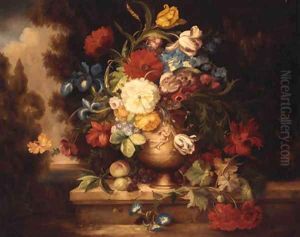Of Jean-Baptiste Monnoyer Paintings
Jean-Baptiste Monnoyer was a Franco-Flemish painter who specialized in still lifes with flowers, which has made him one of the most renowned floral painters of the 17th century. Born in Lille, France (then part of the Spanish Netherlands) in 1636, Monnoyer developed a style that combined the detail-oriented Flemish tradition with the French Baroque's grandeur and elegance.
Monnoyer moved to Paris around 1650 and by 1663, he was working for Louis XIV's Gobelins Manufactory, producing designs for tapestries. His work was highly sought after, and he collaborated with some of the most prominent French artists of the time, including Charles Le Brun, the principal painter to the king and the director of the Gobelins Manufactory. Monnoyer's floral compositions were celebrated for their vivid colors, the accuracy of the flowers, and their sophisticated arrangement.
In addition to tapestry designs, Monnoyer also painted for the royal residences, such as the Château de Versailles and the Grand Trianon. His paintings often served as overdoors or were incorporated into the decorative schemes of the palaces' interiors. He successfully combined artistry with an entrepreneurial spirit, catering to the tastes of the wealthy elite who desired opulent decorations.
Monnoyer's reputation extended beyond France, and he spent a significant amount of time in England, where he worked for the court of King William III and Queen Mary II. In England, he also collaborated with the painter Sir Godfrey Kneller, the leading portraitist in England at the time.
He passed away in London in 1699, leaving behind a legacy that would influence flower painting in France and throughout Europe well into the 18th century. Monnoyer's work was characterized by a harmonious blend of naturalism and decorative arrangement, which has been appreciated by art connoisseurs and collectors over the centuries.
